25 great blues-rock guitar licks lesson
Play in the style of Clapton, SRV, Hendrix, Gilmour, the three Kings, John Mayer and more with our tab and audio lessons

A definitive list of 25 licks spanning the entire blues-rock universe is a contentious thing; we’d all come up with different results. These are simply a set of phrases that could form the core of a superb lick armoury – something that, if you were just starting out, would send you happily into the fray; and which, if you’ve been playing for years might fill out a tired or depleted quiver of arrows.
The truth for any musician is that it’s important to have a grasp on the history and evolution of a musical style, and how the various traits of influential players from each era are related. For example, how is Muddy Waters’ You Need Love connected to Jimmy Page?
We've put together a rundown of the most favoured components, be it harmonically, rhythmically or articulation wise, that reappear in licks from players from the '40s through to today
It’s this type of knowledge that allows us to understand how our favourite players have used influences to inform their own playing. There are very few truly original voices in modern music - only a tiny minority of which are guitarists. In blues and rock, the harmonies and rhythms are often quite simple, but what is amazing is how great players down the decades have manipulated this relatively simple musical language and articulated it in their own way.
It’s important to have a grasp on the history and evolution of a musical style
We've put together a rundown of the most favoured components, be it harmonically, rhythmically or articulation wise, that reappear in licks from players from the '40s through to today. The lesson features 25 licks, in descending numerical order, each with a unique component that has been ‘borrowed’ from one or more iconic player.
You could use this lesson in one of two different ways. First, as a chops-building workout, whereby you play the licks back to back. This would be great for stamina and focus if you are to perform all 25 correctly, in one hit. Alternatively, you can view each lick as an individual study idea in its own right.
Work on exploring the musical elements further, then invent ideas of your own using players you like as inspiration - combined, of course, with your own creative steam!
Get the MusicRadar Newsletter
Want all the hottest music and gear news, reviews, deals, features and more, direct to your inbox? Sign up here.
Why not select a few of the elements discussed and write a 12-bar study using them exclusively – can you make it sound natural, like a piece of music and not just a collection of contrived phrases stuck together? This type of musically creative practice is what the pros do. Good luck, and have fun!
Click on the top right of tab to enlarge
1. Freddie King major motif
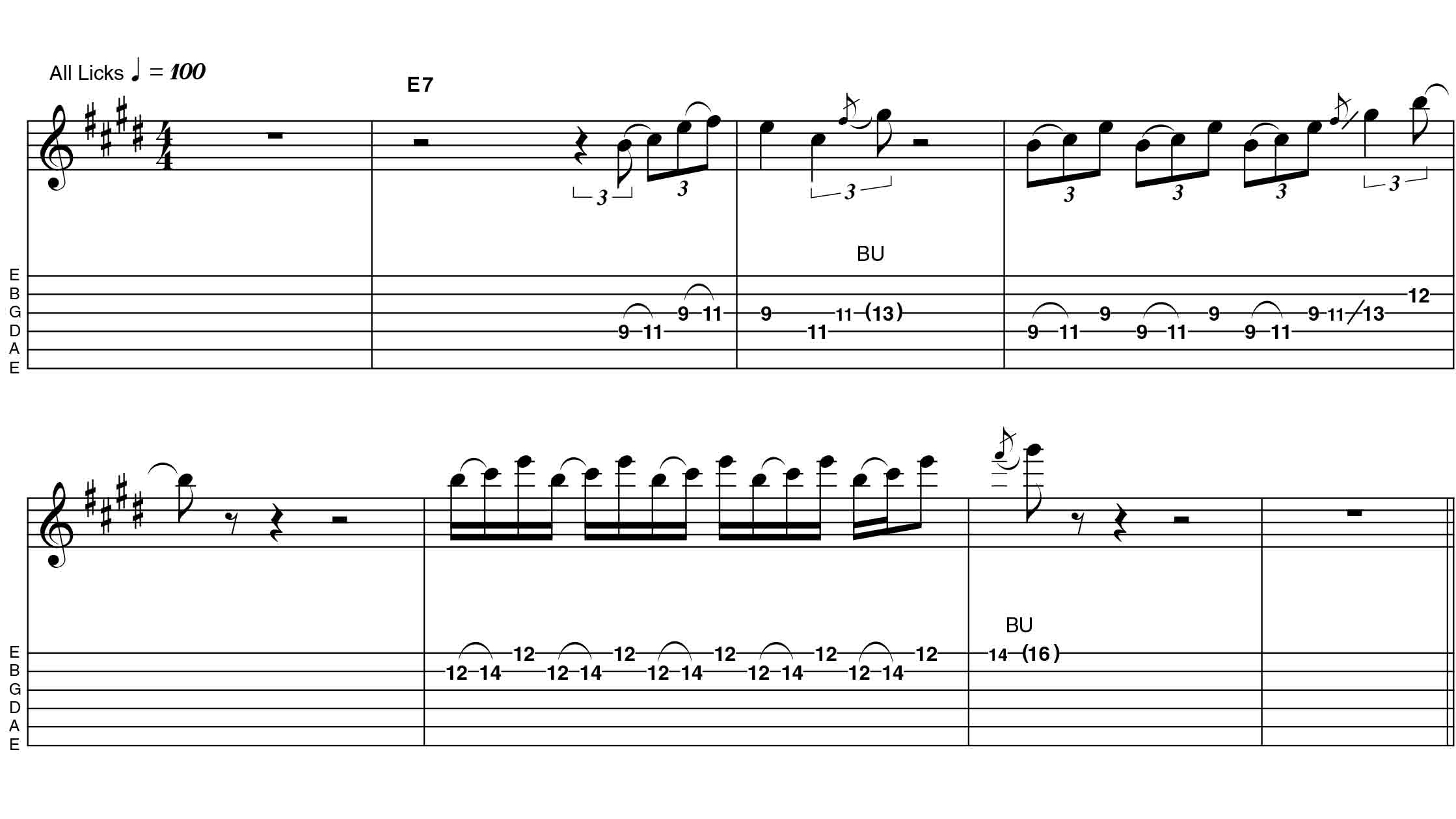
This major pentatonic repeating idea is a Freddie King staple. He used a triplet grouping, whereas Beatle George Harrison applied a cool rhythmic displacement idea in 16th notes on Hard Days Night.
This idea rears its head once more in Paul Kossoff’s amazingly vocal solo in Free’s All Right Now. And in a country setting, you can hear it in Ruby Don’t Take Your Love To Town, by Kenny Rogers.
2. Angus Young-style Minor to major pentatonic
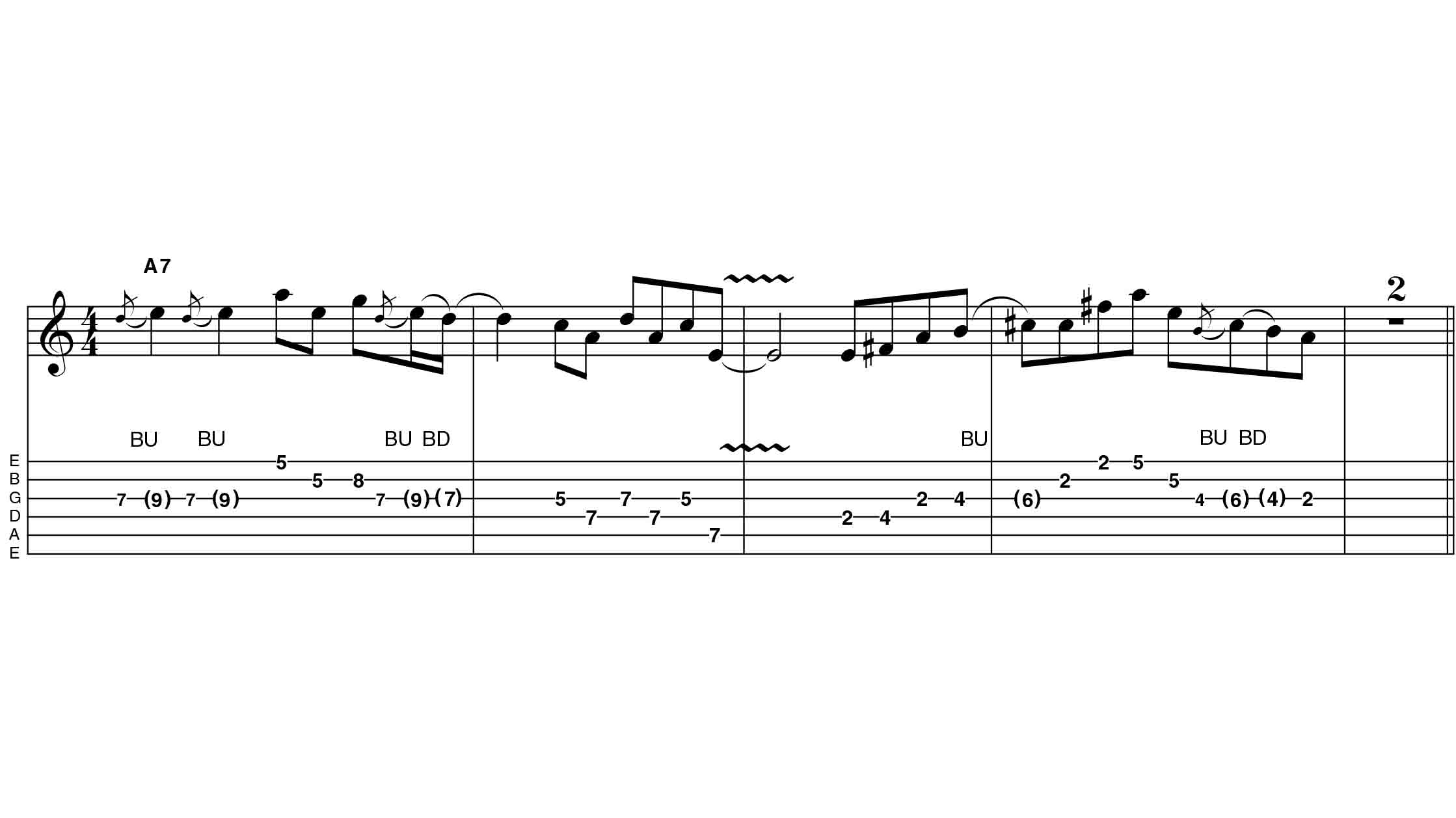
A common trick that blues-rockers use over a dominant chord is to play both the major and minor pentatonic scales from the same key centre (A, in this case). This is often done by using the same scale fingering for A minor (at the 5th fret), then moving it down three frets, to become A major (at the 2nd).
Players ranging from Angus Young to Paul Gilbert frequently apply this idea.
3. Mark Knopfler and Peter Green Minor 7 arpeggio fragment
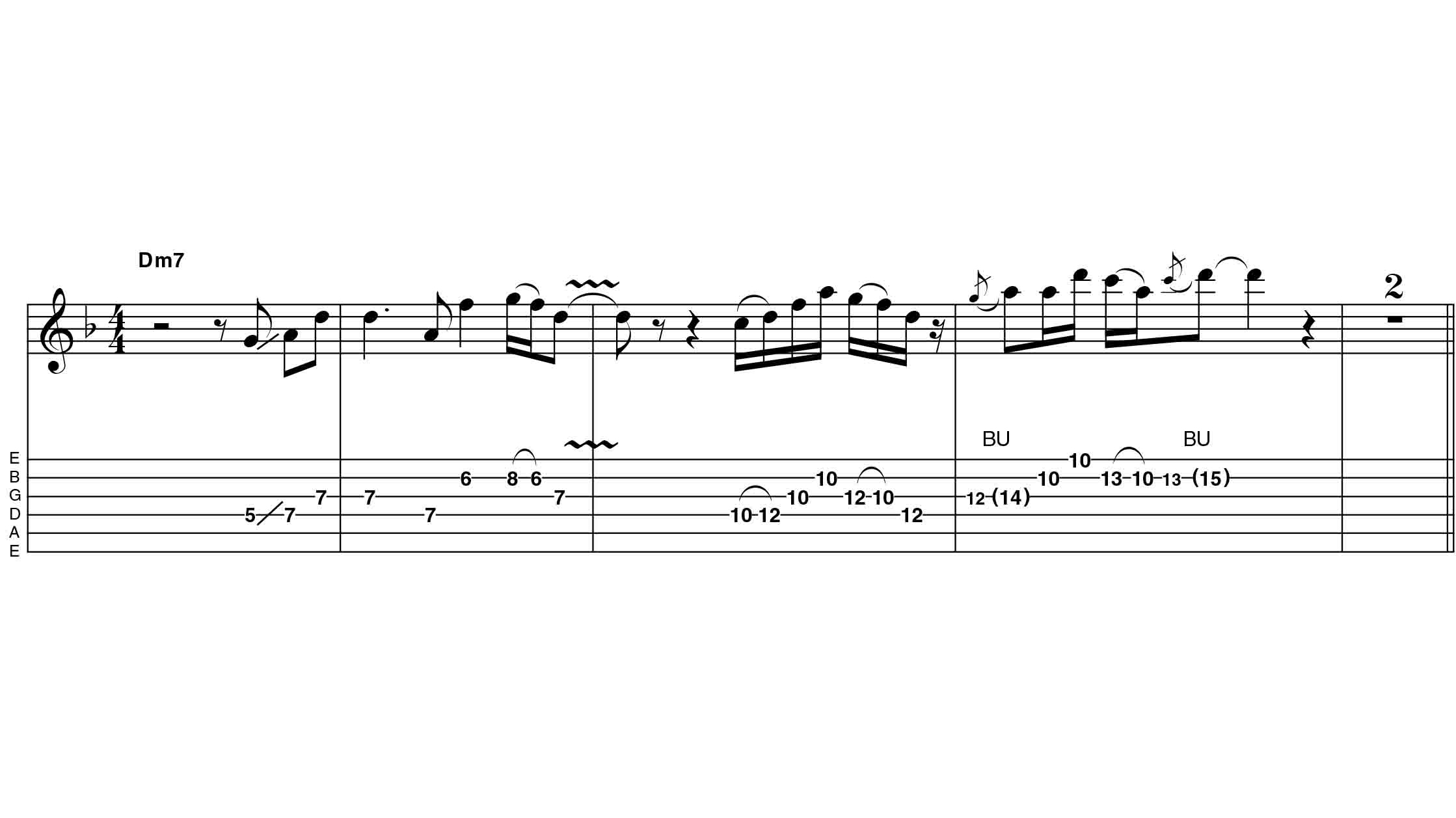
This lick is an example of how a sterile musical device, such as an arpeggio, can be decorated to great effect. Three guitarists that excel at this and spring instantly to mind are Mark Knopfler, Peter Green and Eric Clapton.
Our example features a decorated D minor (D-F-A) and minor 7 (D-F-A-C) arpeggio. Arpeggios are an instant route to ‘chord tone targeting’ and always sound great!
4. Organ licks
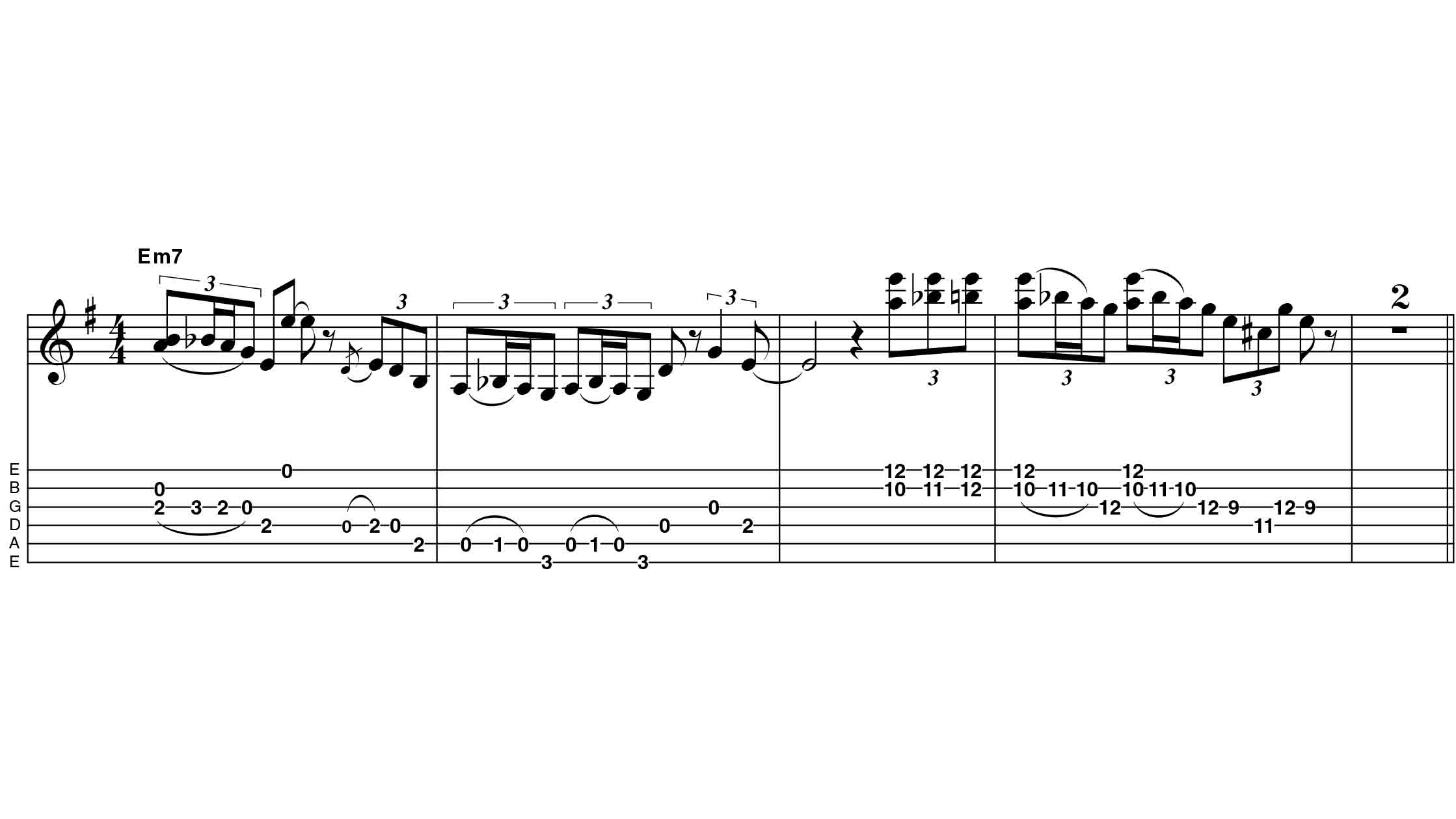
Some players such as Danny Gatton, Robben Ford and Stevie Ray Vaughan take influence from organ players like Jimmy Smith, resulting in some very cool double-stop and trilling ideas.
Try using hybrid picking for a balanced and dynamic delivery.
5. Rock 'n' roll pull-offs
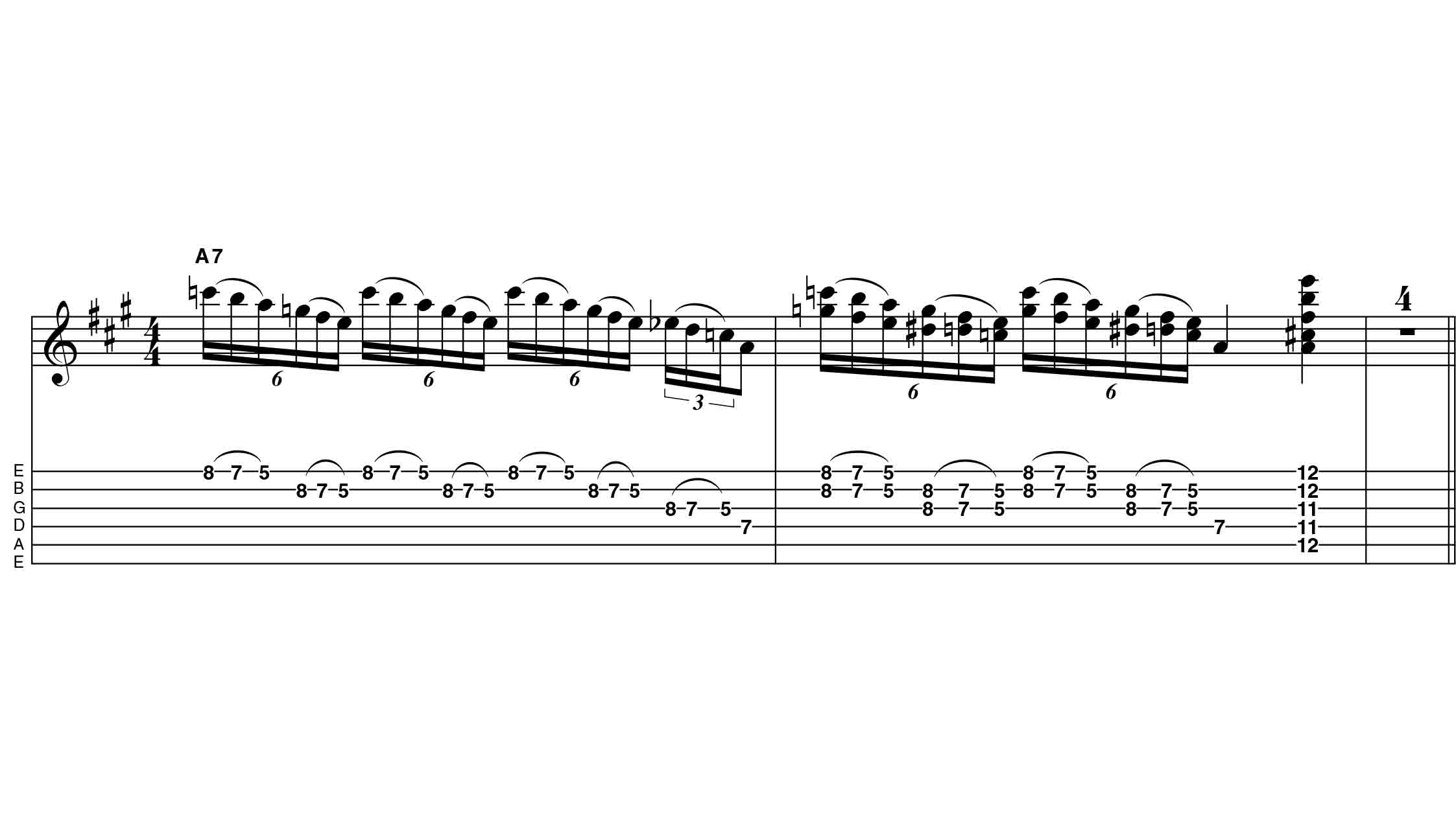
Before '70s rockers popularised the use of rapid fire pull-offs, Elvis’s guitarist Scotty Moore, Eddie Cochran and Gene Vincent’s amazing Cliff Gallup were putting them to great use back in the '50s.
They would have got the idea from Les Paul, but the lick has become a rockabilly staple (think Brian Setzer) and has been also picked up by the great Jeff Beck (a huge Cliff Gallup and Les Paul fan).
6. Pedal point licks
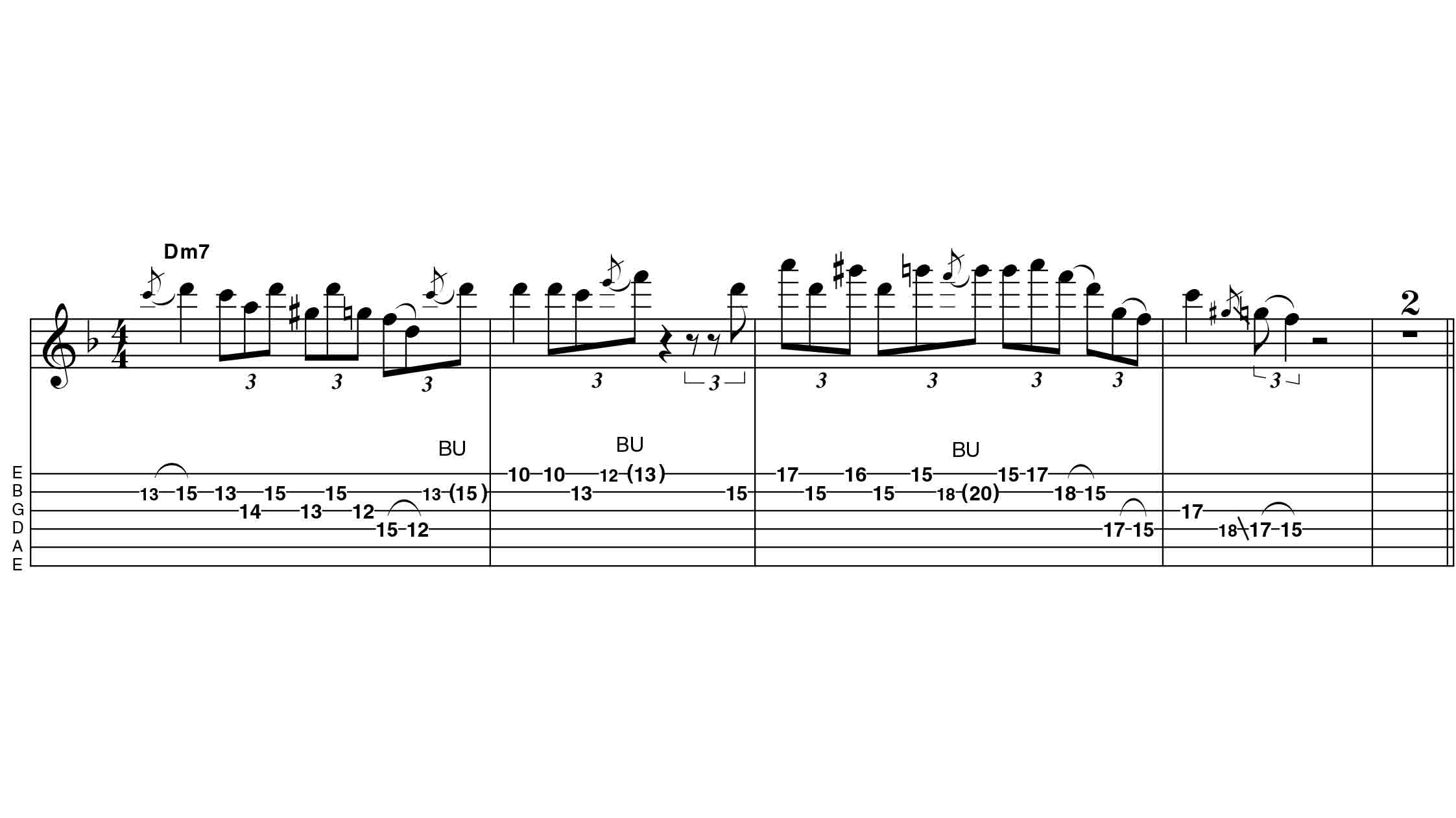
It’s not just classically influenced players such as Yngwie Malmsteen who use pedal point ideas!
This is a common blues variation, whereby the root of the scale (D) is used as a pedal, against a descending line of notes (A-Ab-G) or (5th-b5-4th).
7. Hendrix exchange bend
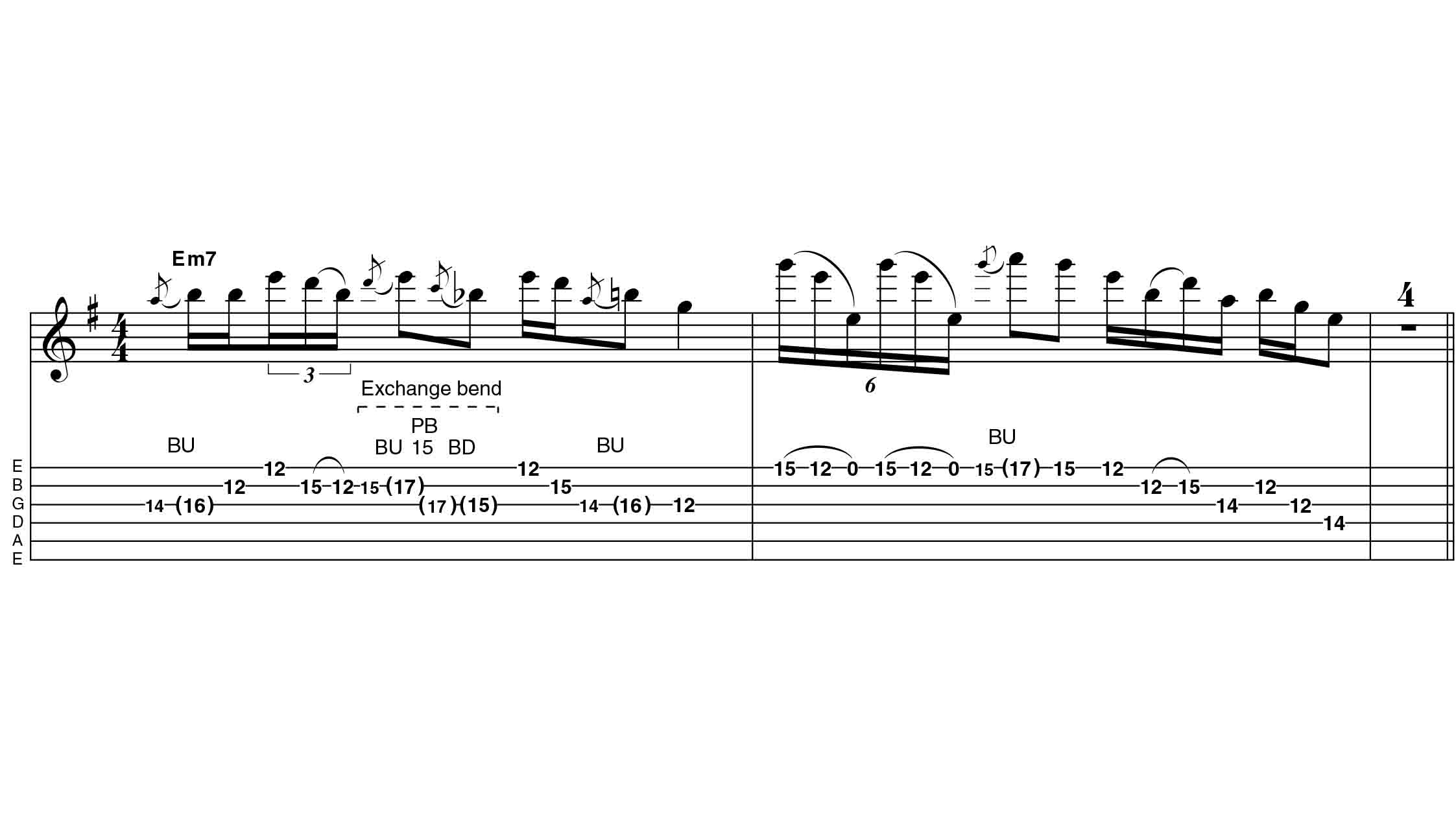
This Jimi Hendrix-inspired bending idea has been used by Steve Lukather, Van Halen and Joe Walsh among others.
The trick is to deftly ‘switch ‘ strings at the height of the 15th-fret second-string bend, to the third string, which is then let down.
8. Moveable octave fragments
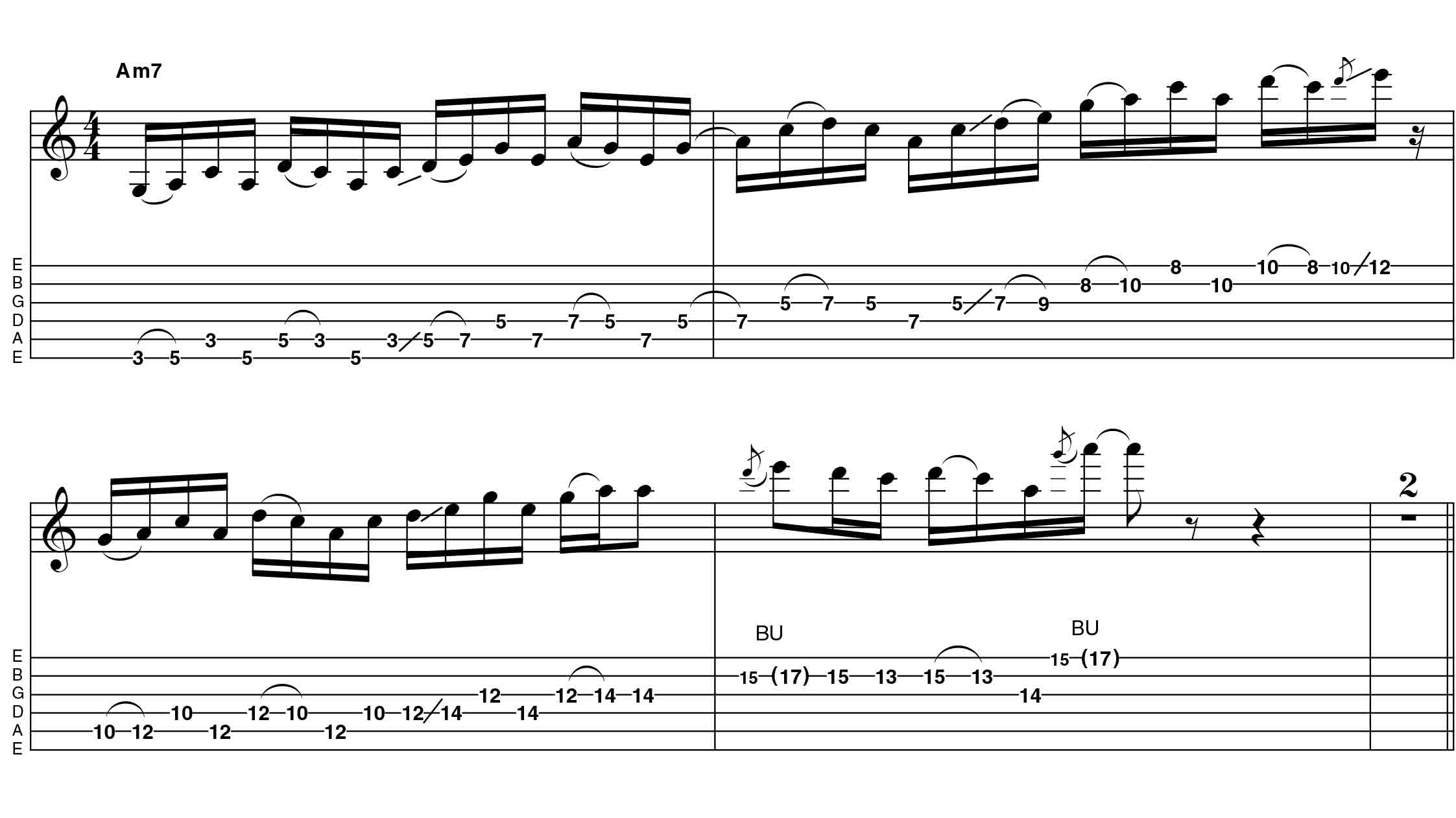
In a bid to break the curse of ‘box’ playing, we can take smaller fragments of the scale and sequence them in octaves.
Everyone from Wes Montgomery to George Benson, Jimmy Page and Jimi Hendrix have put this idea to great use.
9. 6th intervals
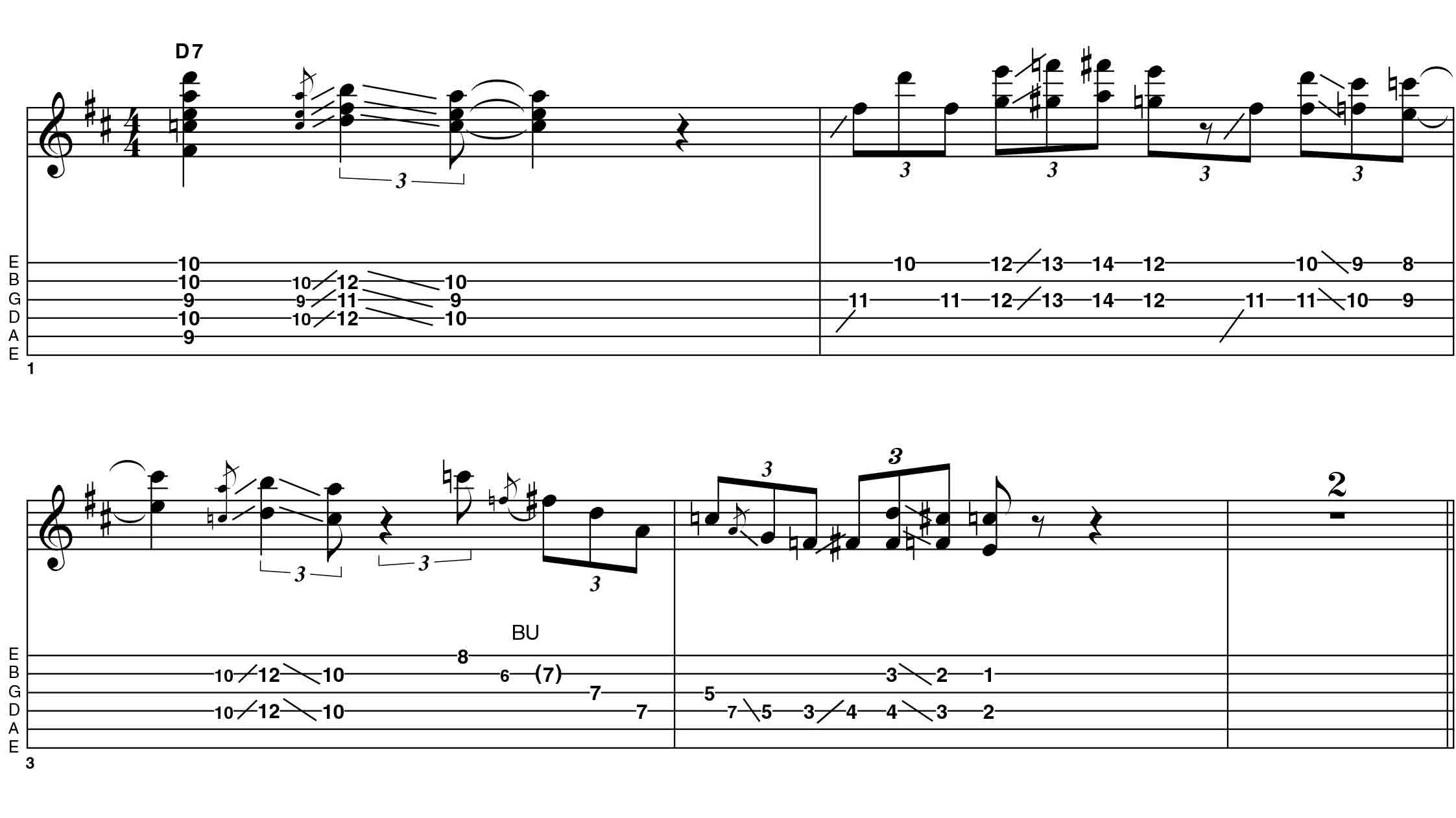
6ths are brilliant at creating great hooks: think of Steve Cropper’s intro to Soul Man, The Allman Brothers’ version of Stormy Monday, Jimi’s Red House intro or Freddie King’s ‘6ths breakdown’ in Hideaway! They’re great for embellishing rhythm parts, too.
10. Hendrix lead/rhythm style
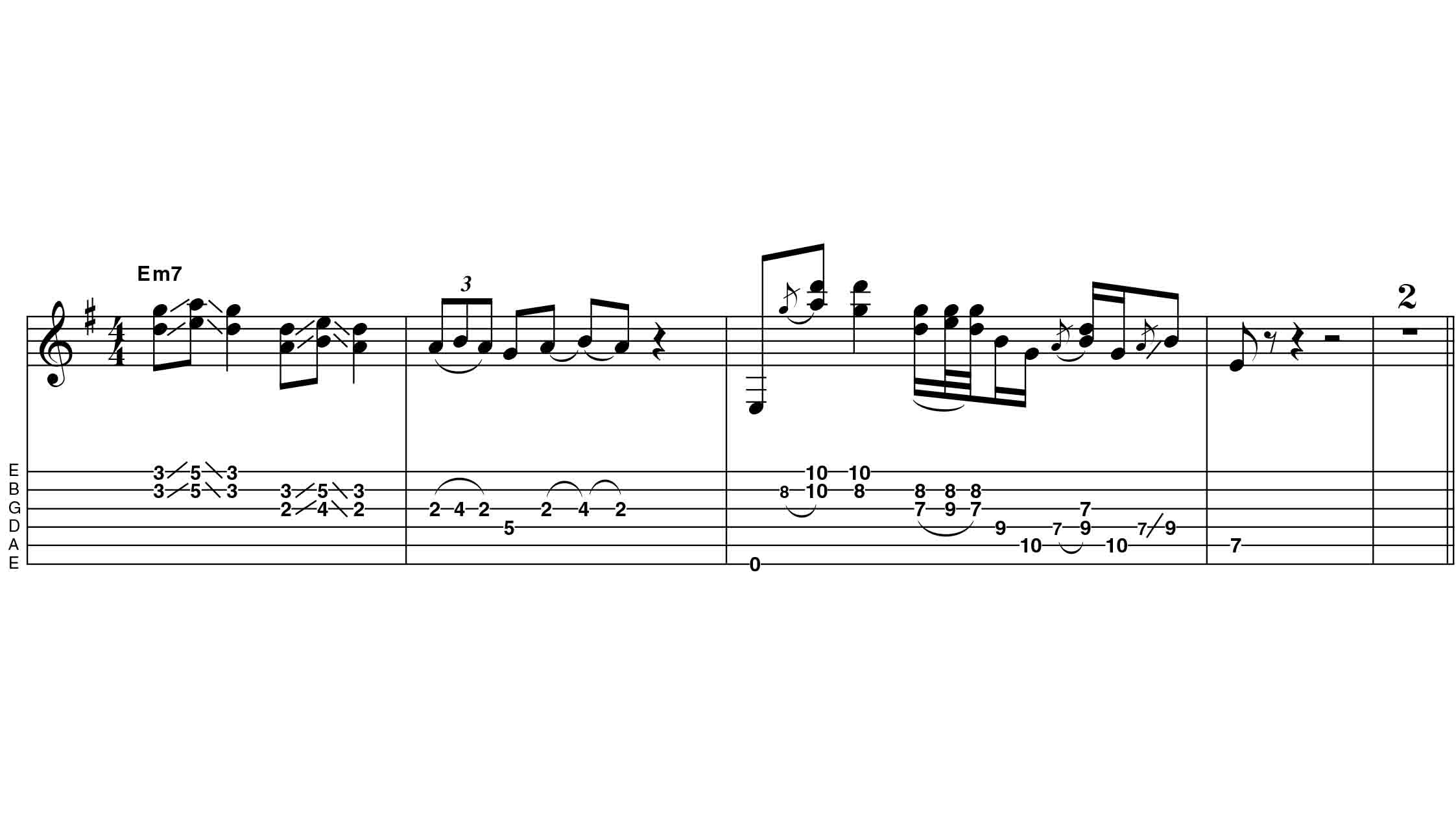
Jimi Hendrix took his highly influential rhythm and lead style from soul giant Curtis Mayfield, composed from pentatonic scales in 4ths, first inversion major chords and decorative hammer-ons (think Little Wing, The Wind Cries Mary, etc).
Guitarists as diverse as Steve Vai, Stevie Ray Vaughan and John Mayer have also employed this highly effective approach.
11. Major/minor mixing
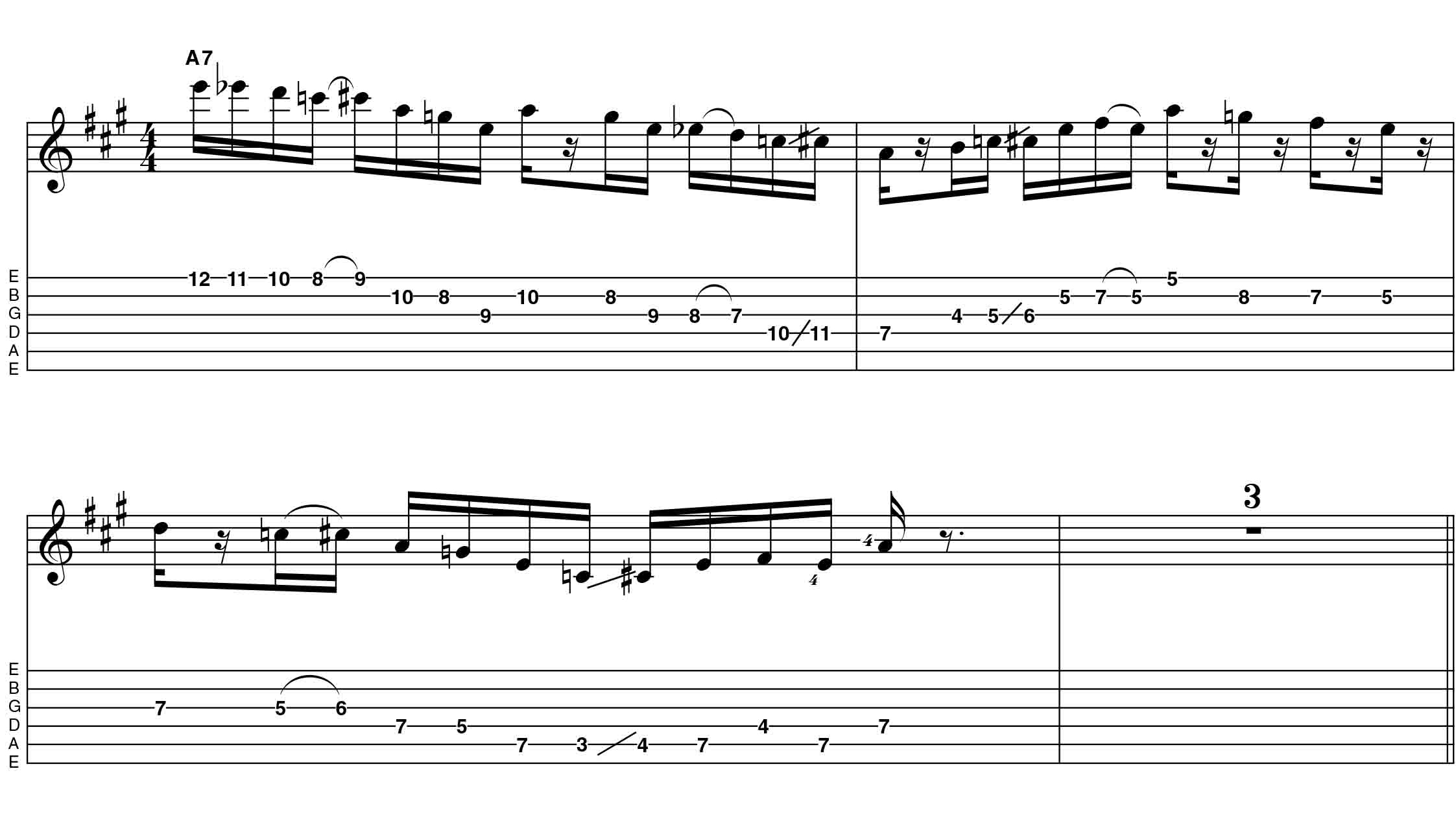
Many blues-rock players claim to know little about ‘modal’ scales such as Mixolydian (R-2-3-4-5-6-b7), but you wouldn’t know it from listening to them. Often, a ‘note pool’, akin to a bigger ‘modal-sounding’ scale, is formed by combining two smaller scales.
In this case, it's the minor Blues (R-b3-4-b5-5-b7) and major Pentatonic (R-2-3-5-6), resulting in a ‘uber’ Mixolydian scale (R-2-b3-3-4-b5-5-6-b7).
12. Sweep/rakes
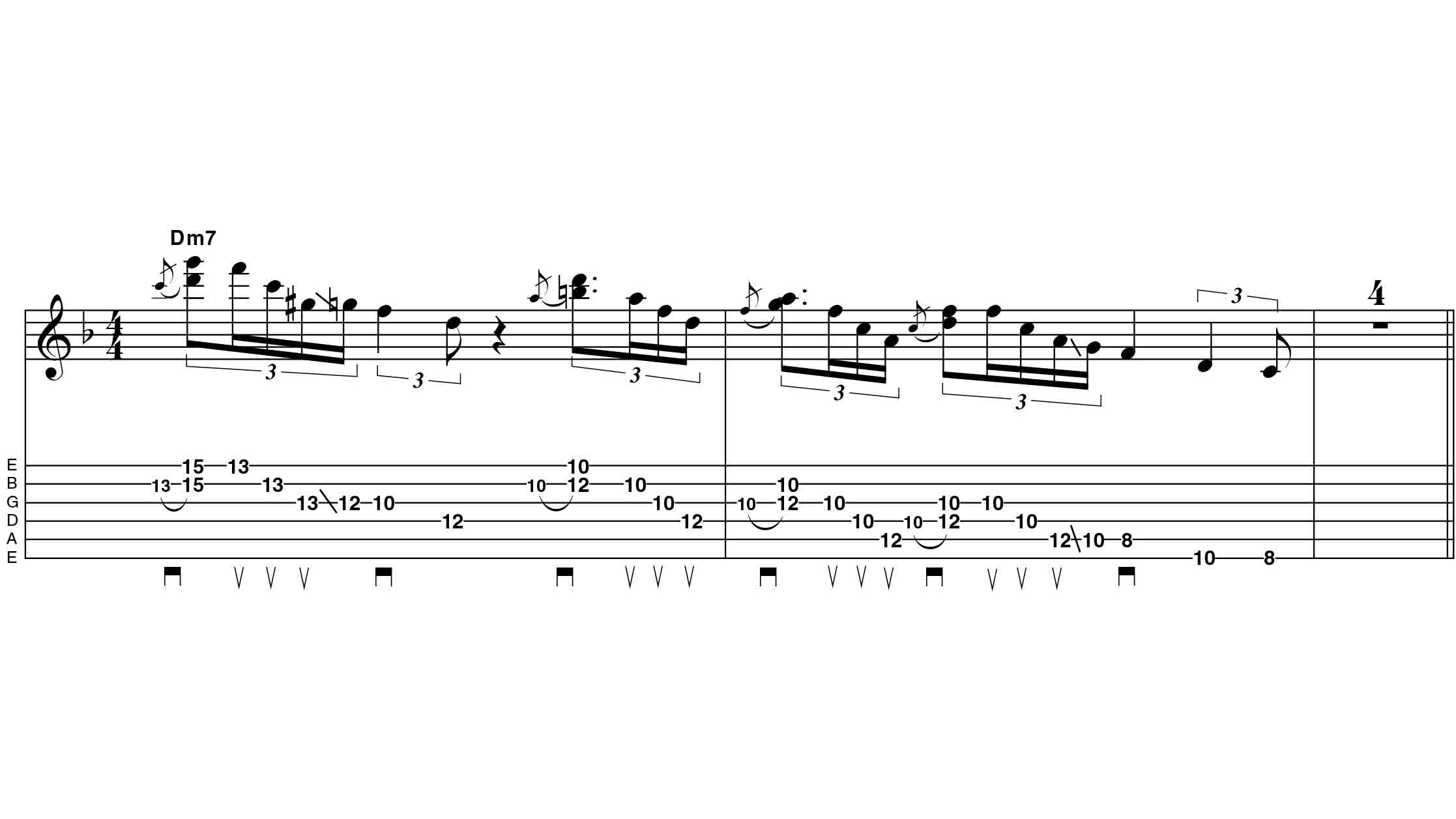
This idea provides a clever turn of speed and works a little like a reverse sweep pick. The idea is to ‘rake’ back towards the lower strings producing a cascade of notes.
You can hear this technique used by Robben Ford, Stevie Ray Vaughan, and more recently, John Mayer, Matt Schofield and jazz-blues maestro Oz Noy.
Aim for a smooth, but rhythmic delivery with added ‘sting’ on the target notes.
13. Unison bend
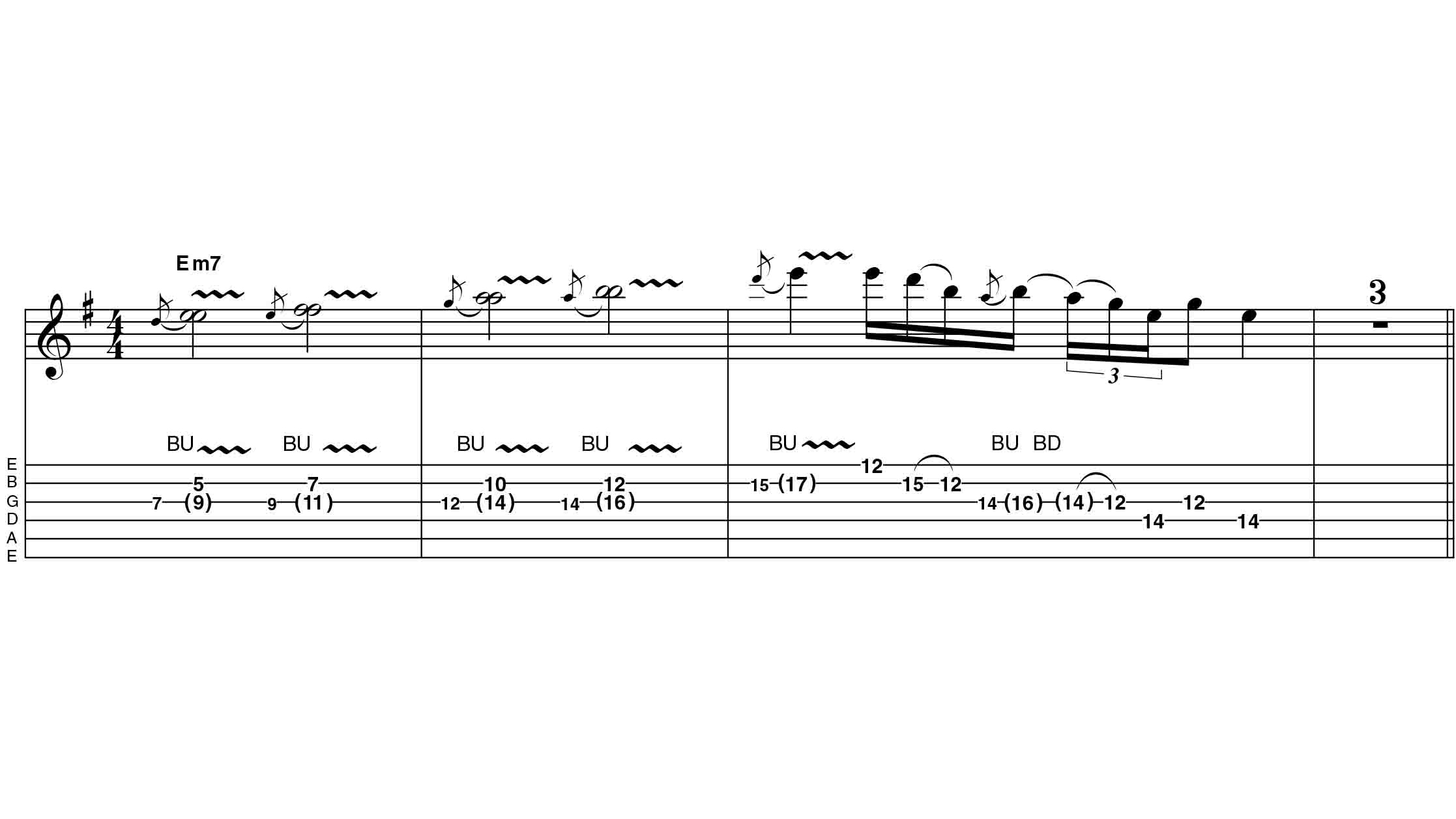
A great way to built intensity in a solo. Hendrix was fond of these and used them to fantastic effect in Manic Depression. And check out Jimmy Page’s intro to Joe Cocker’s With A Little Help From My Friends.
Add some vibrato and make those position shifts smooth.
14. SRV flat 9

This is probably the most lifted Stevie Ray Vaughan lick ever! The rapid hammer-on and pull-off between the root (A) and b9 (Bb) shouldn’t work theoretically, but Stevie proves that if it sounds good, it is good! Countless SRV disciples certainly think so!
15. Hindu pentatonic
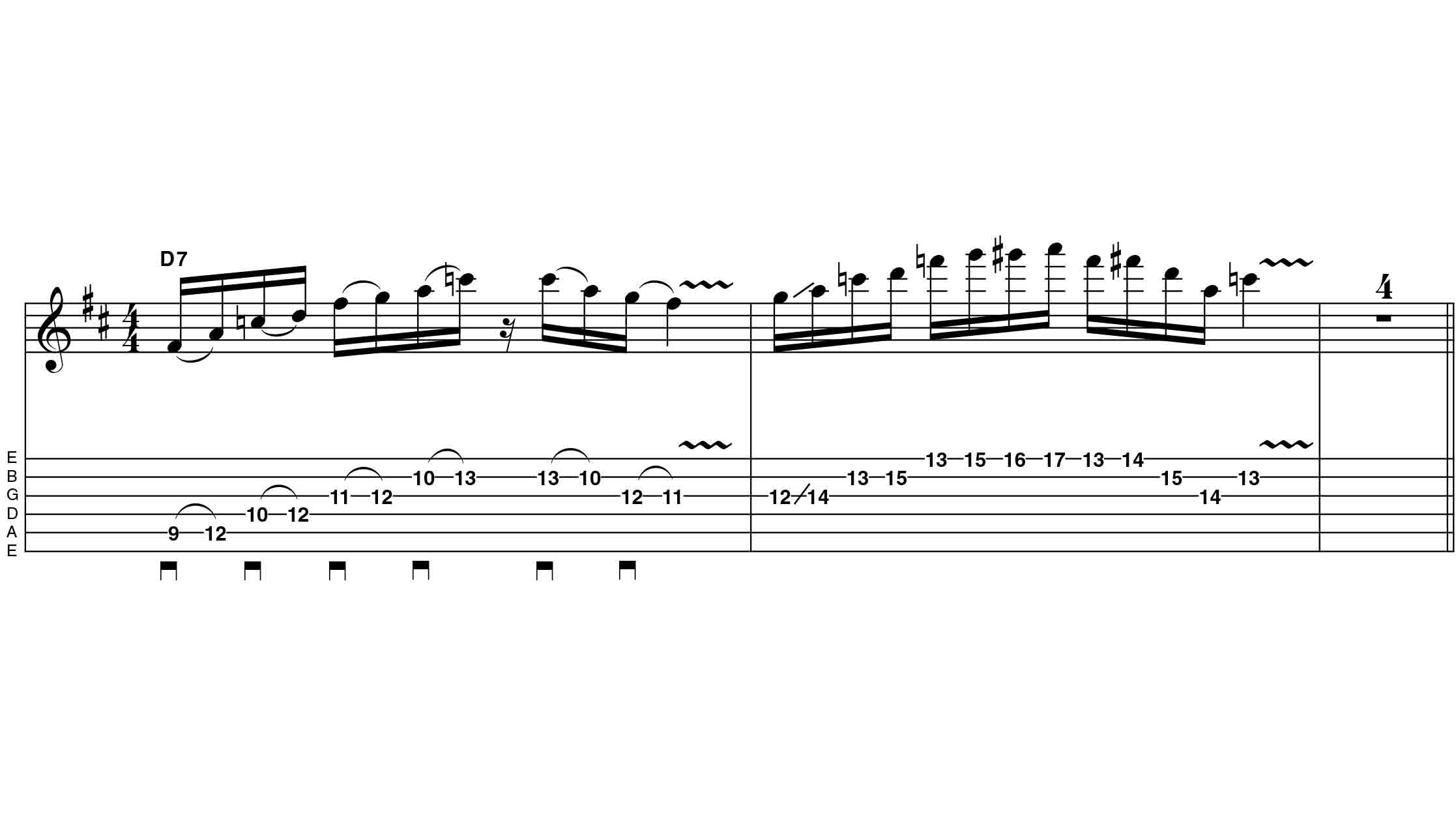
The rather more exotic Hindu scale (R-3-4-5-b7) can be seen as a minor Pentatonic but with a major 3rd replacing the minor 3rd.
Jeff Beck used this frequently in his '70s period (Led Boots), as have Eric Johnson and Steve Vai! The Beatles also famously used it as a Mellotron fill after the second chorus of Strawberry Fields Forever, before Lennon sings the line, “No-one I think is in my tree...”
16. Speedy pentatonics

Some rapid-fire pentatonic ideas in the style of the mighty Gary Moore. These sequences may have been popularised by Gary, but players such as Alvin Lee and Frank Marino have also put similar patterns to great use!
17. Doublestops
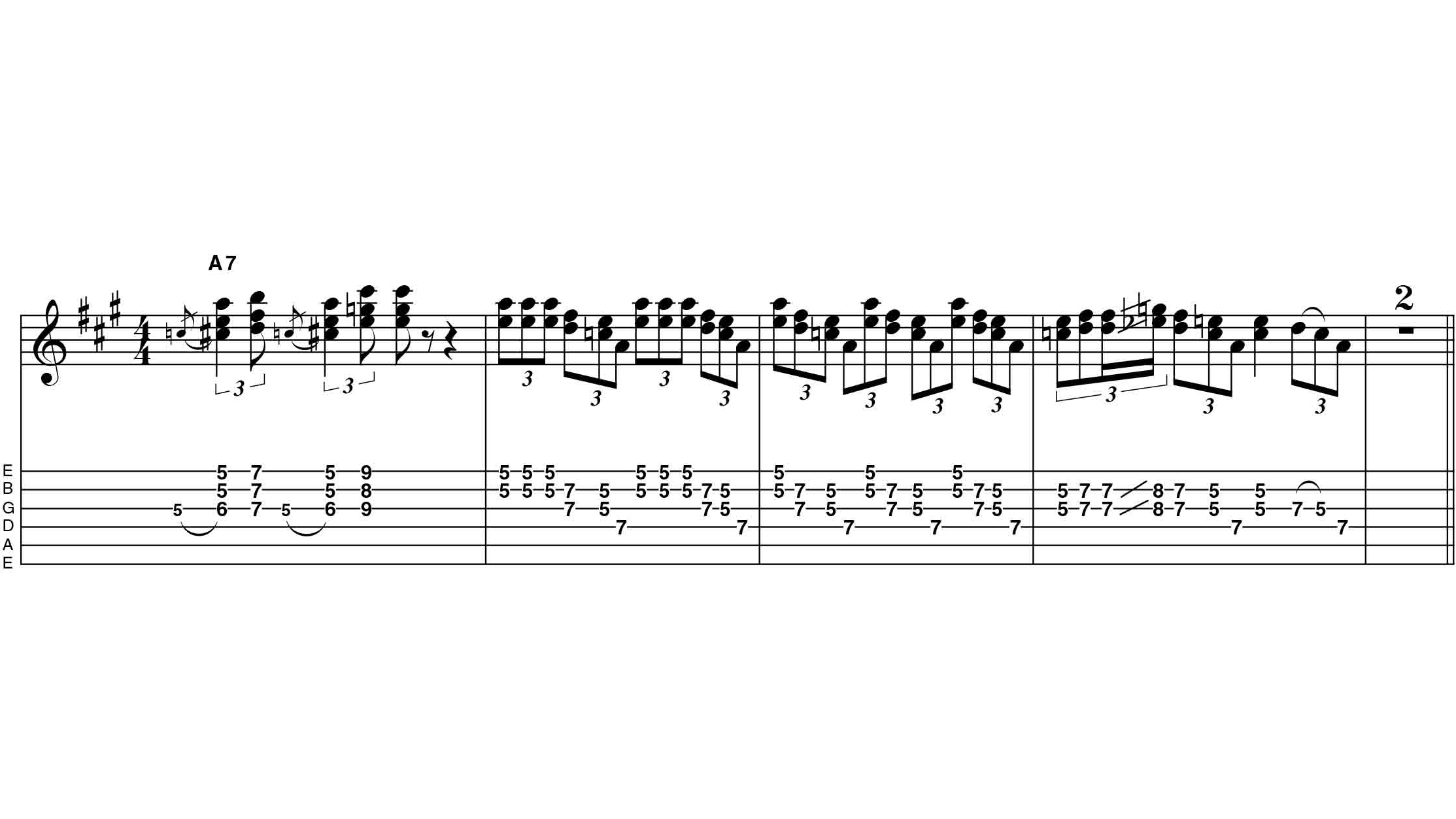
A series of doublestop moves now, starting with a favourite of SRV’s older sibling, Jimmie Vaughan. We follow with some Chuck Berry/Keith Richards style phrases.
Chuck and Keef get great mileage from such ideas by utilising clever rhythmic displacement.
18. Minor pentatonic add2
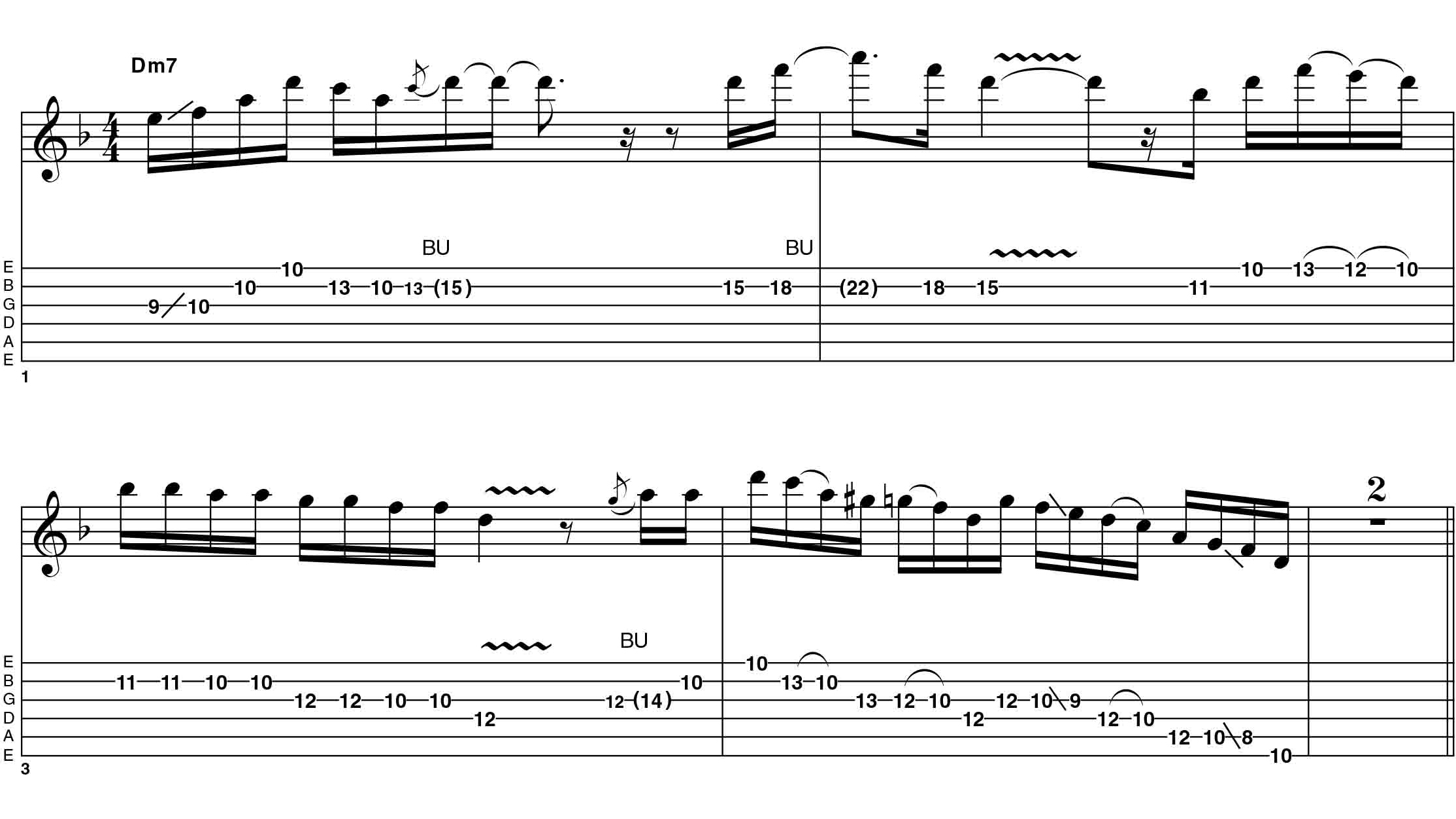
A super-effective way to bring colour to the often predictable minor pentatonic is to add a 2nd interval, in this case an E note.
Jimmy Page demonstrates this on the Led Zep slow blues classic, Since I’ve Been Loving You; Jeff Beck’s opening lick in Cause We’ve Ended As Lovers employs it; Santana can be heard using the idea on Europa, and it’s also a favourite of David Gilmour and Chris Rea.
19. Descending 16th note patterns
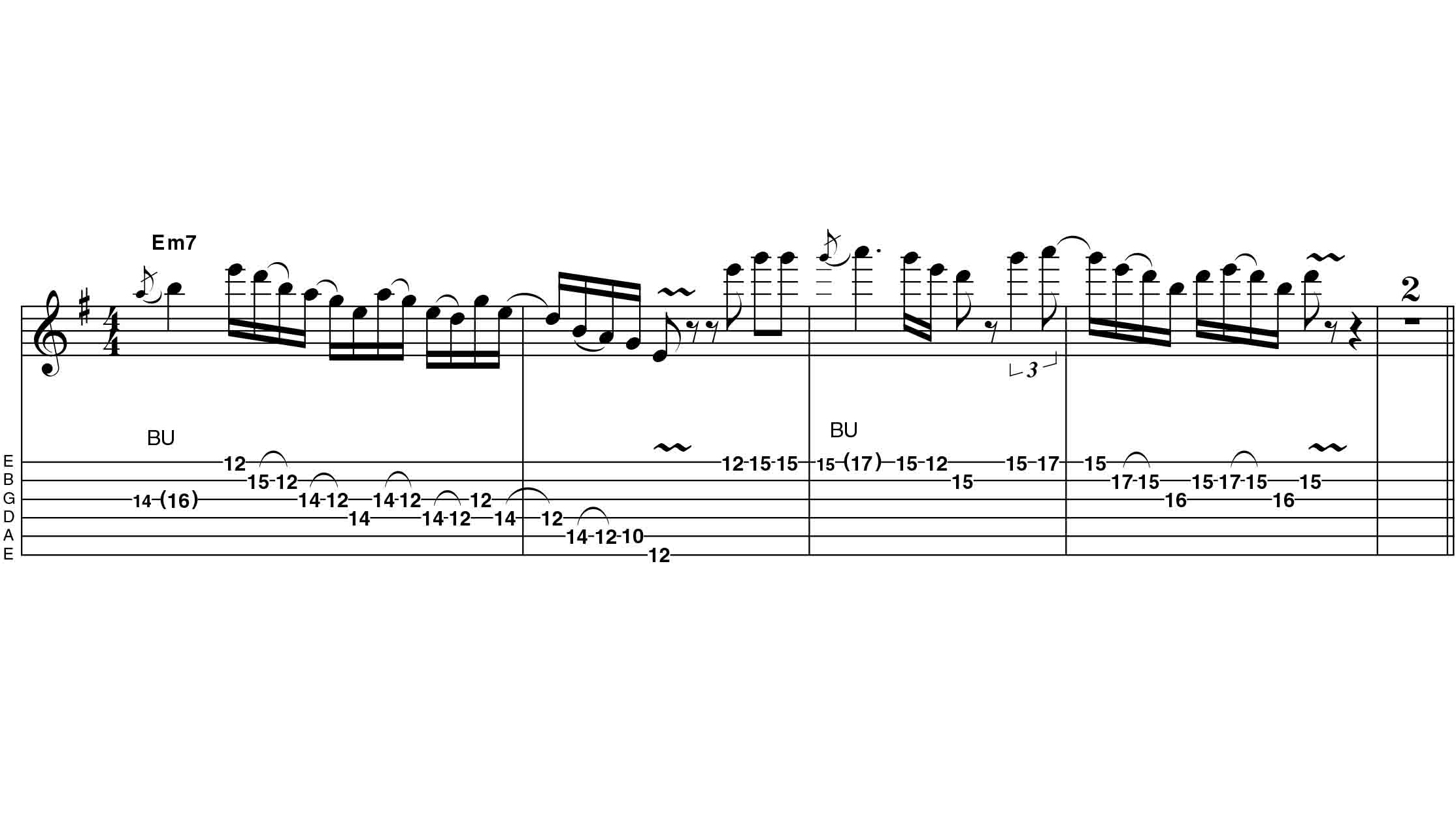
Another Jimmy Page trait, with this descending 16th-note minor pentatonic sequence reminiscent of his Stairway To Heaven solo intro.
This has become something of a standardised idea across the blues-rock universe.
20. Albert King step bend
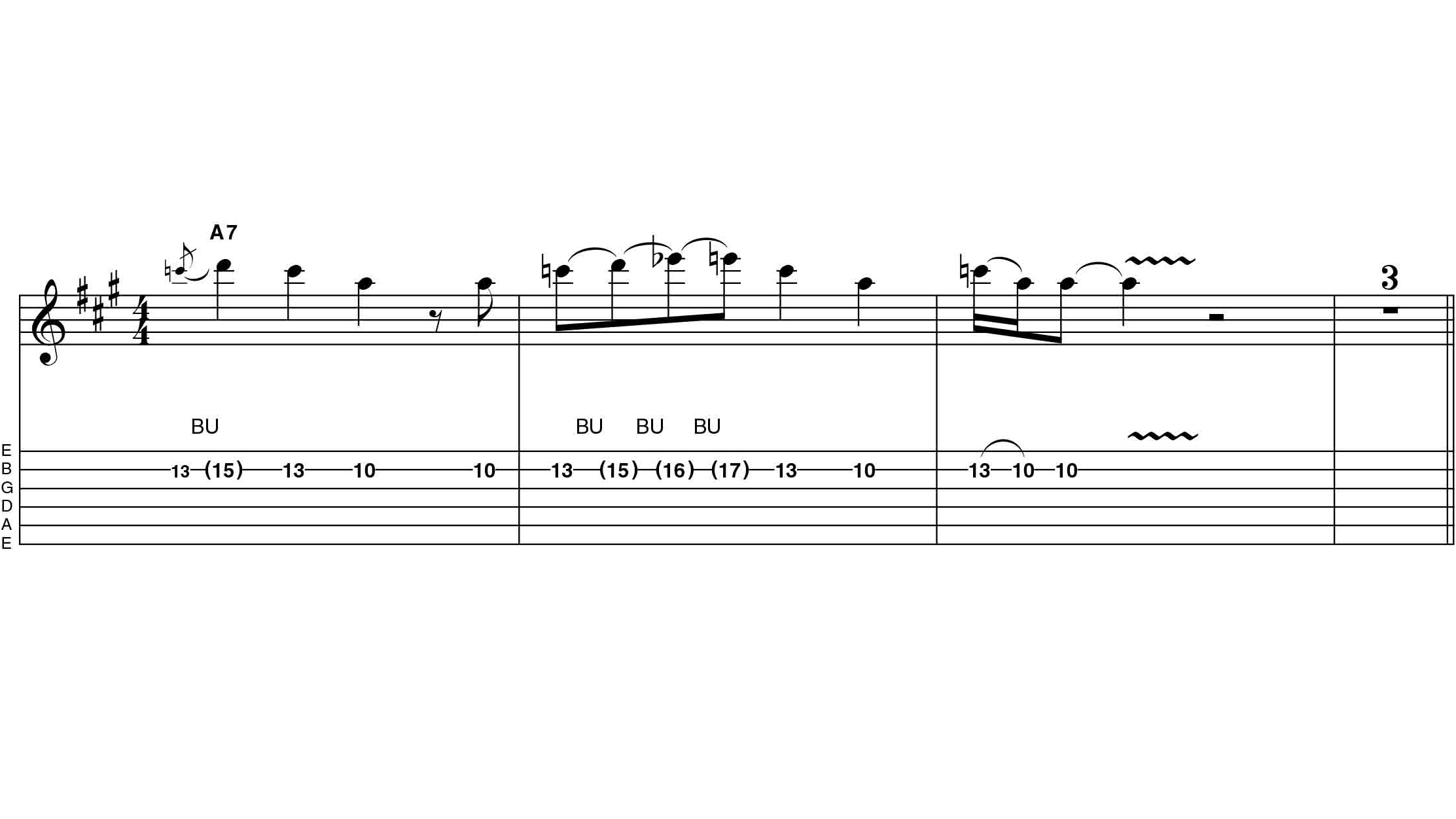
Some scary Albert King-style bending now, in the shape of this stepped bend idea, whereby a single note is bent in stages to outline an ascending scale. Don’t flex the fingers, but use the wrist instead to take the weight; and always support the bending finger with others.
You should clearly see how this type of progressive wide bending technique was adopted by David Gilmour.
21. 3 against 4 repeating figures
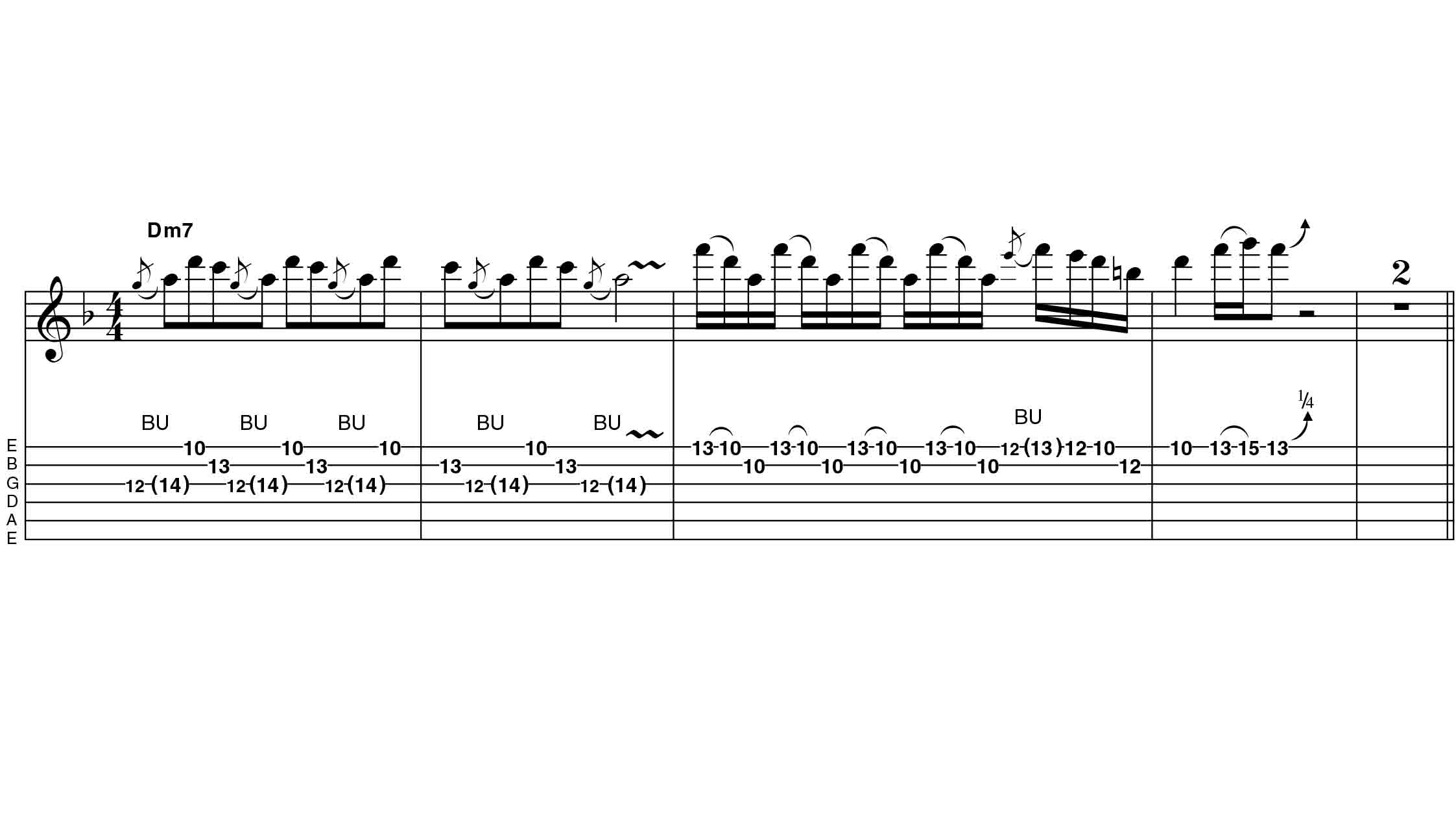
Repetitious figures feature heavily in blues-rock. Bar 1 features a classic Slash-style move, using a three-note motif but played against a rhythmic pulse of four notes per beat, resulting in a clever rhythmic displacement.
Bar 2 demonstrates a similar rhythmic idea but using a minor arpeggio - you’ll hear it in Hotel California, the climax of Page’s Stairway solo and many a Cream live jam.
22. Triplet repeating lick
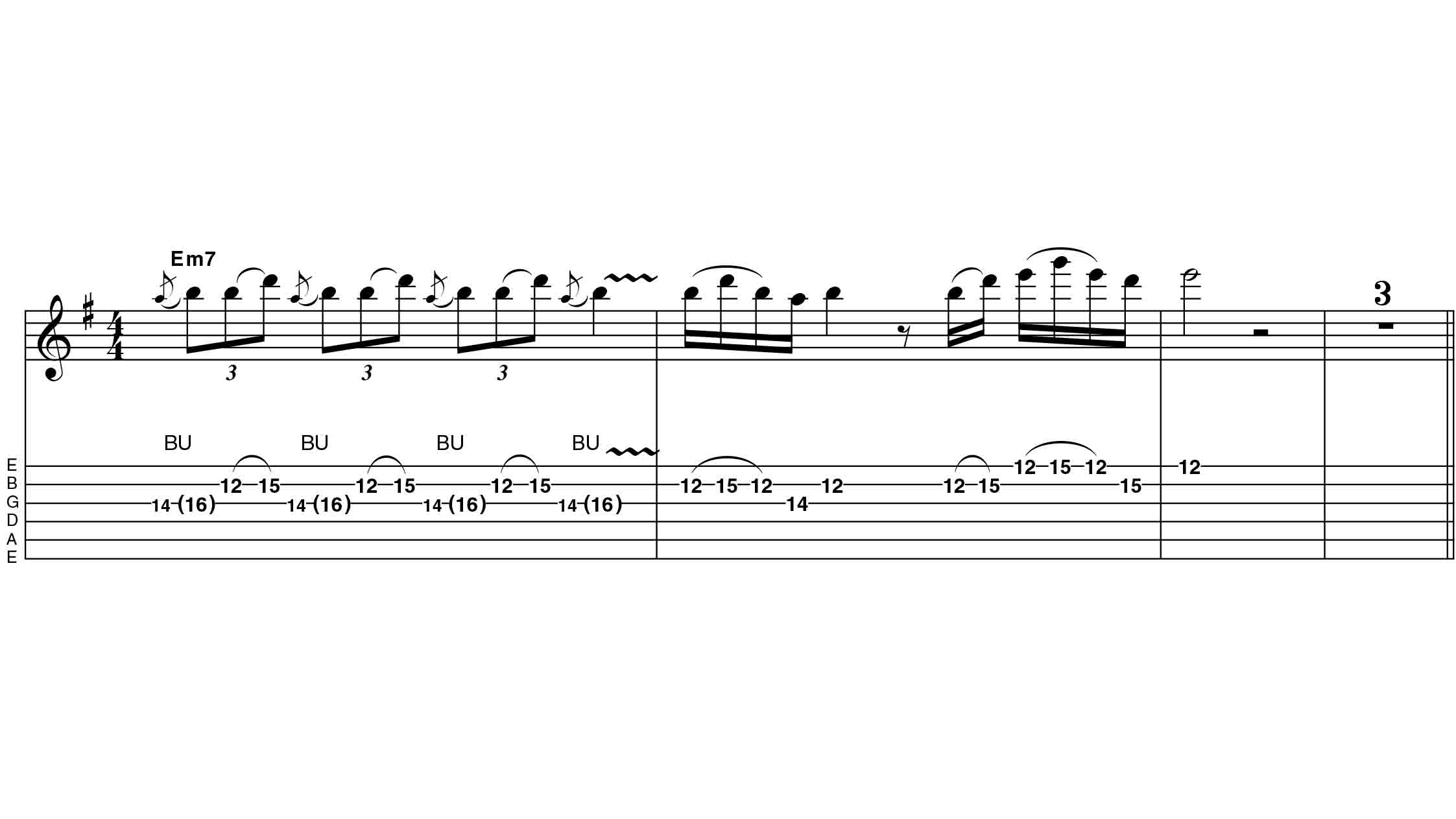
In keeping with blues tradition, this three-note Clapton-inspired idea is played in triplets. We finish the idea with a couple of 16th-note flourishes to contrast, a la Howlin’ Wolf.
You may well hear a similarity to one of EC’s most well-loved guitar parts
23. Chuck Berry string bend repeating figure
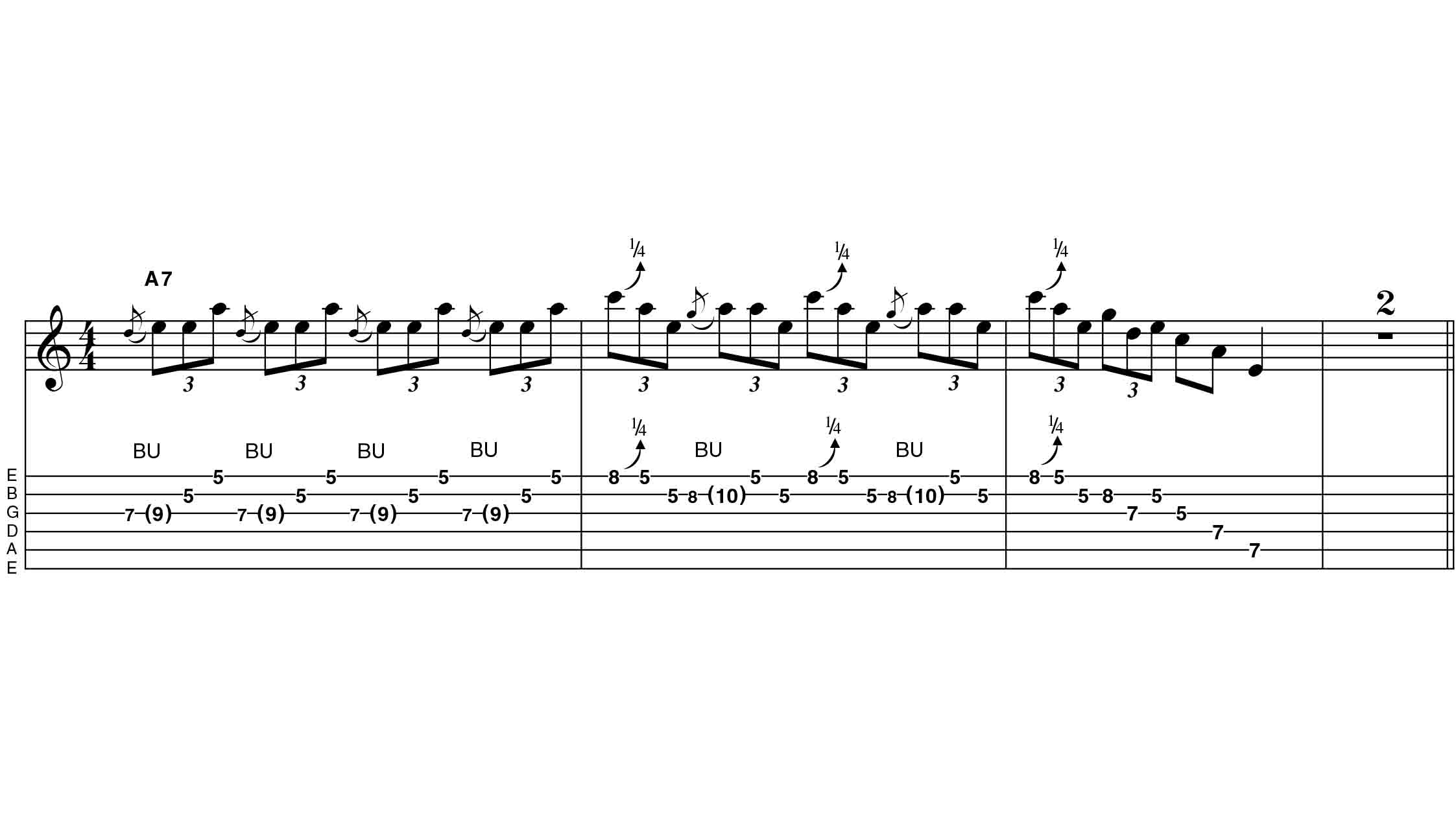
The second repeating motif is the classic Chuck Berry figure, which is a mainstay in this genre and used by practically everybody from Keith Richards and George Harrison to AC/DC’s Angus Young.
The second bar is a more embellished and modern sounding variation as used by both Jimi Hendrix and Joe Satriani.
24. BB King minor/major box pattern
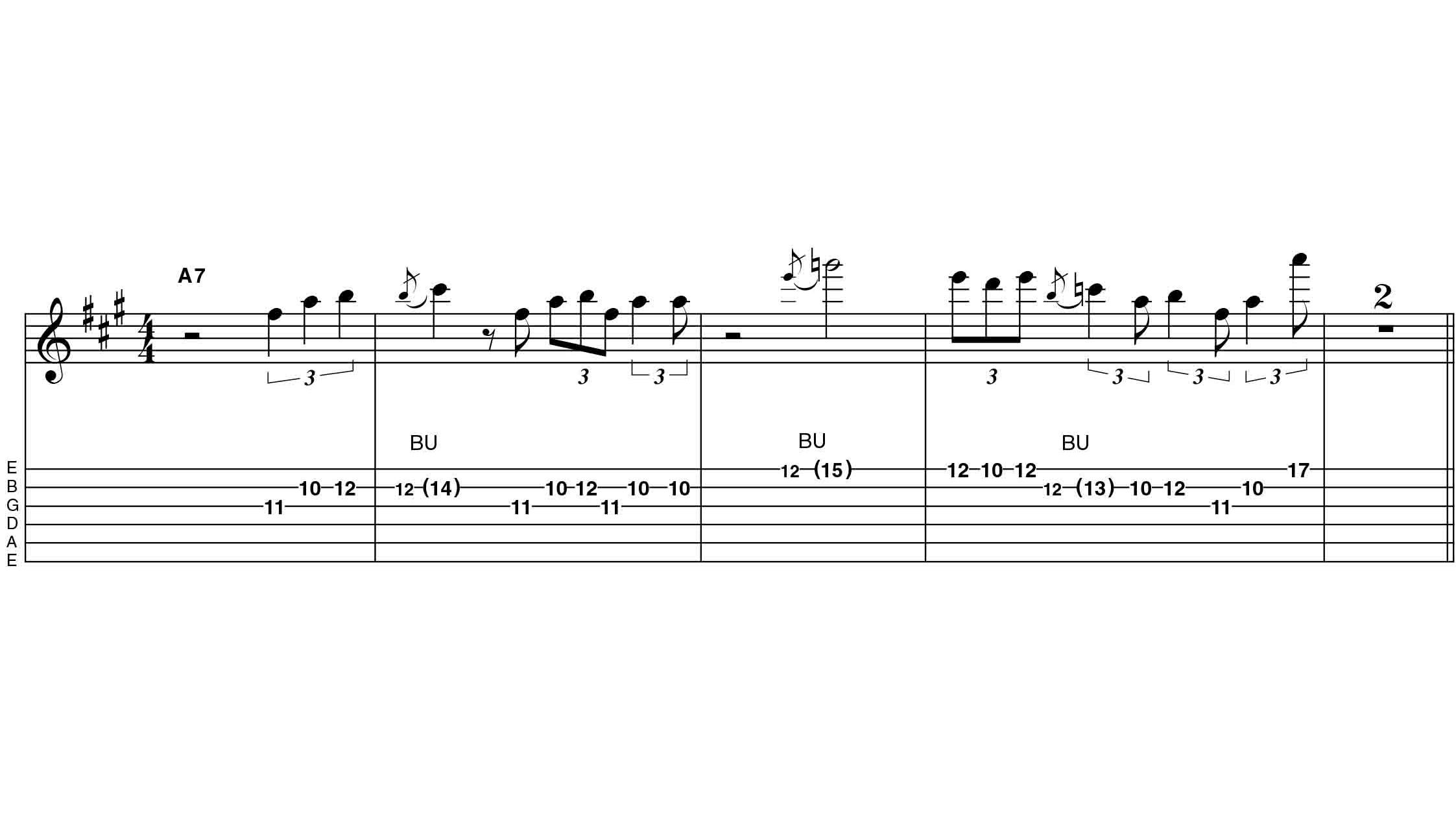
Although BB King’s earlier work often used the familiar shapes 1 and 2 of the minor pentatonic, for the last few decades he made this particular scale or ‘box’ shape his own.
You can hear Peter Green utilising it beautifully on the Fleetwood Mac classic, Need Your Love So Bad, and more recently by John Mayer on his modern blues masterpiece, Gravity.
25. Open-position E minor pentatonic
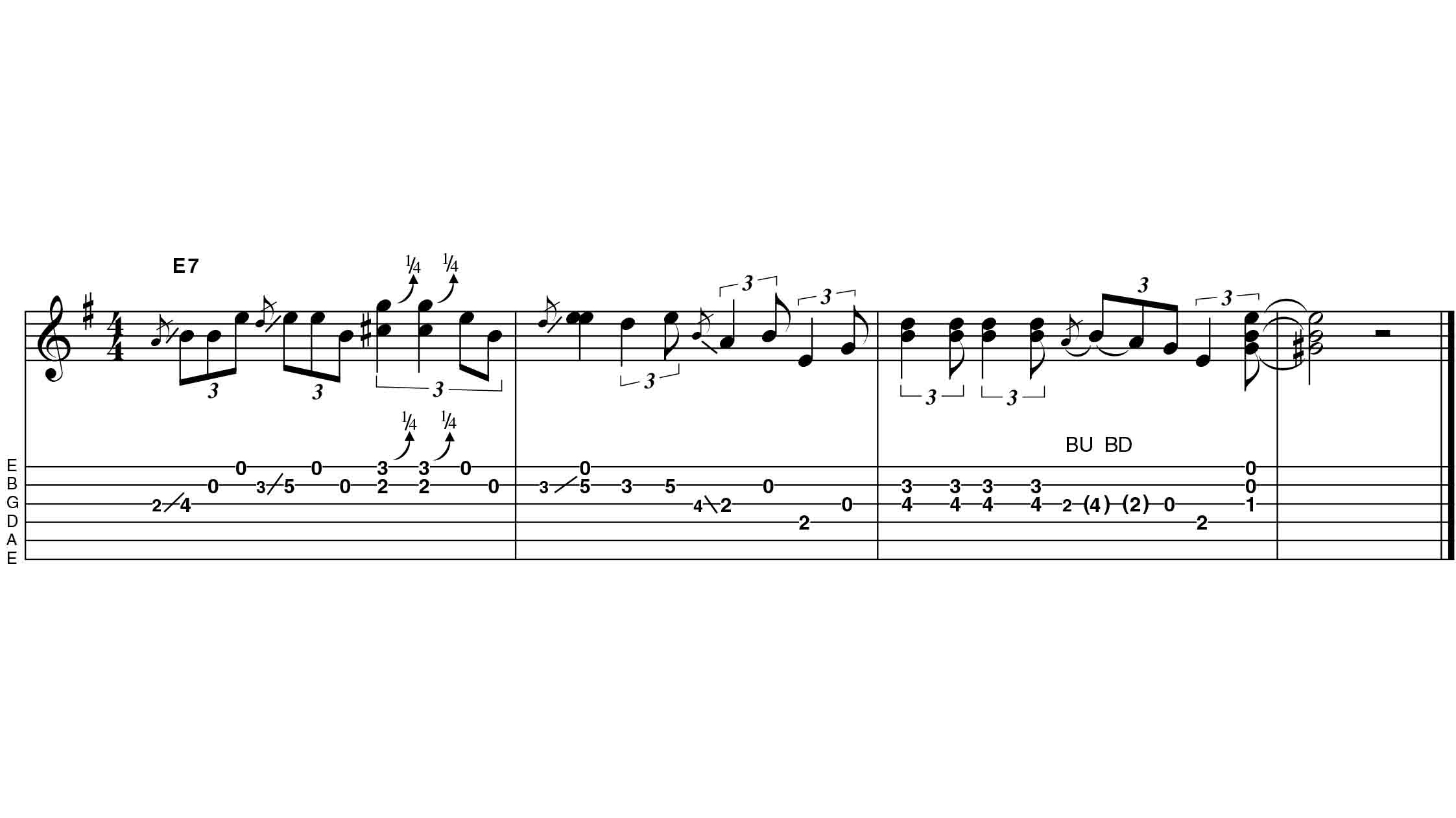
This fingering and the available vocabulary makes it our number favourite lick.
It’s rife in the playing of every blues or rock guitarist, as it spans the music of early blues elder statesmen Robert Johnson, John Lee Hooker and Muddy Waters, and has been utilised by Hendrix (Hey Joe, Voodoo Chile), David Gilmour (Wish You Were Here), SRV (Scuttle Buttin), Slash (Civil War) and many more.









